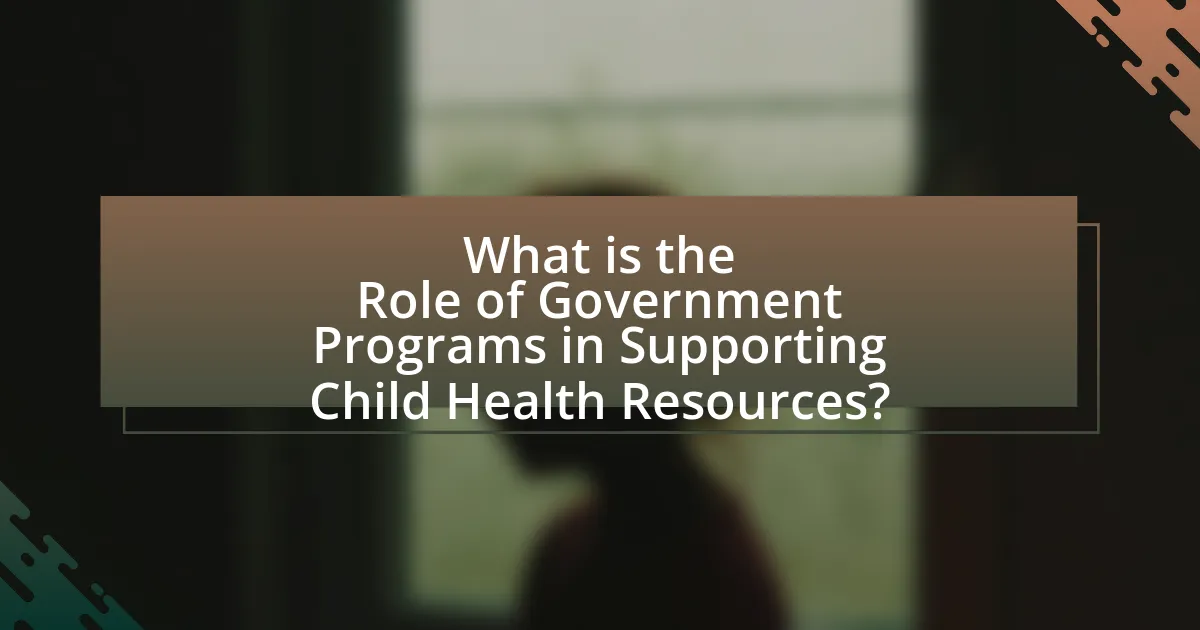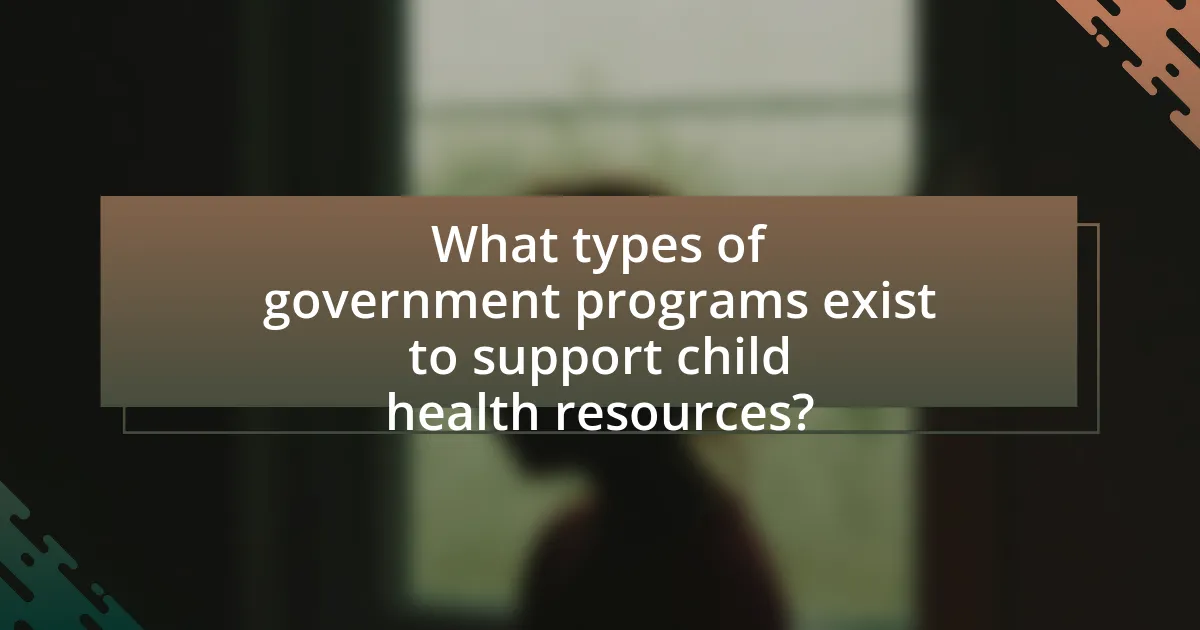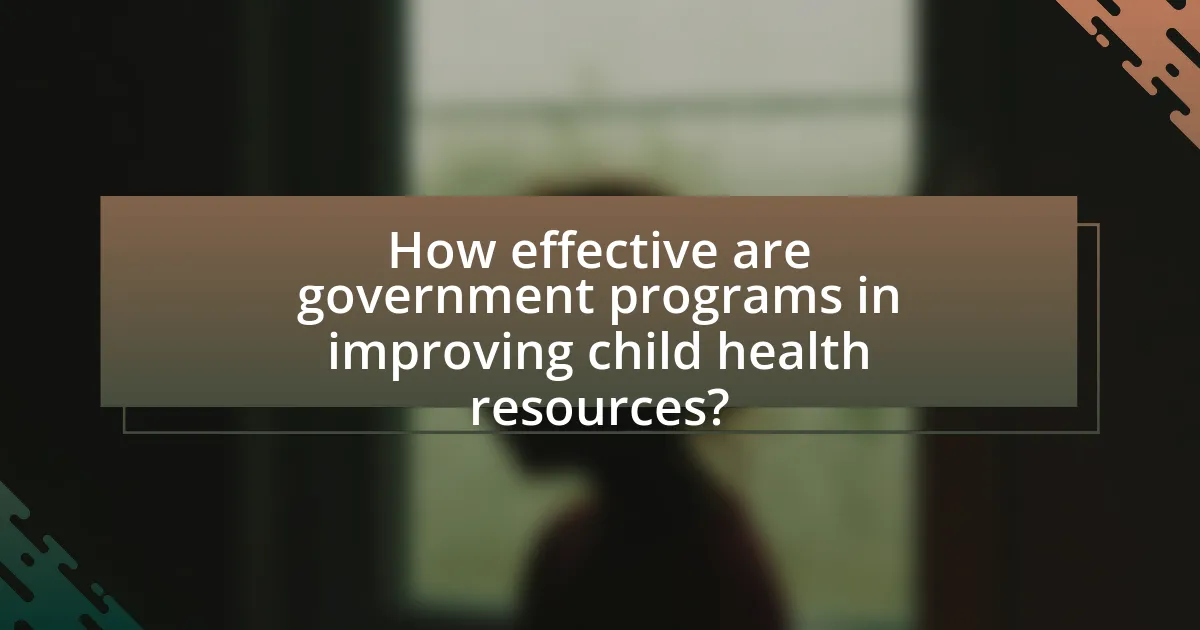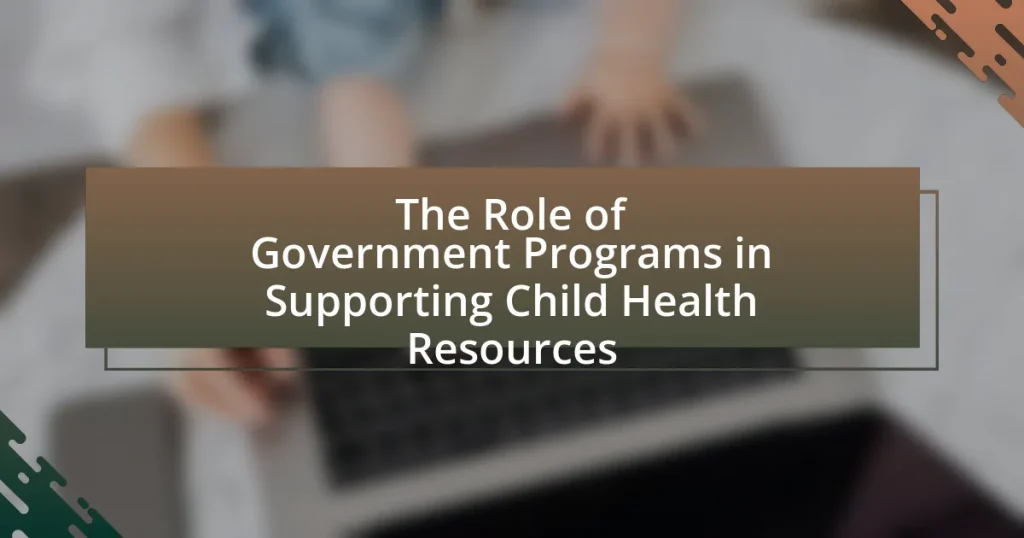The article focuses on the critical role of government programs in supporting child health resources, highlighting initiatives such as Medicaid, the Children’s Health Insurance Program (CHIP), and the Women, Infants, and Children (WIC) program. It discusses how these programs provide essential healthcare access, preventive care, and nutritional support, significantly improving health outcomes for millions of children. The article also examines the impact of these programs on reducing health disparities, addressing specific health issues, and promoting overall child wellness, while outlining the challenges faced and best practices for enhancing government support in child health initiatives. Additionally, it explores future trends in technology and policy changes that may shape the landscape of child health resources.

What is the Role of Government Programs in Supporting Child Health Resources?
Government programs play a crucial role in supporting child health resources by providing funding, access to healthcare services, and preventive care initiatives. These programs, such as Medicaid and the Children’s Health Insurance Program (CHIP), ensure that millions of children receive necessary medical care, vaccinations, and health screenings. For instance, according to the Centers for Medicare & Medicaid Services, Medicaid and CHIP cover over 35 million children, significantly reducing uninsured rates and improving health outcomes. Additionally, government initiatives like the Women, Infants, and Children (WIC) program offer nutritional support, which is vital for the healthy development of children. These programs collectively enhance child health by addressing barriers to access and promoting overall well-being.
How do government programs impact child health outcomes?
Government programs significantly improve child health outcomes by providing access to essential healthcare services, nutrition, and preventive care. For instance, programs like Medicaid and the Children’s Health Insurance Program (CHIP) have expanded health coverage to millions of children, resulting in increased access to vaccinations and regular check-ups. Research indicates that children enrolled in these programs experience lower rates of hospitalization and improved overall health metrics. A study published in the Journal of the American Medical Association found that Medicaid expansion led to a 20% decrease in uninsured rates among children, directly correlating with better health outcomes.
What specific health issues do these programs address?
Government programs addressing child health resources specifically target issues such as malnutrition, obesity, mental health disorders, and access to preventive care. These programs, like the Supplemental Nutrition Assistance Program (SNAP) and the Children’s Health Insurance Program (CHIP), aim to reduce food insecurity and ensure that children receive necessary medical services. For instance, studies show that participation in SNAP can lead to improved dietary quality among children, while CHIP has significantly increased health insurance coverage for low-income families, thereby enhancing access to essential health services.
How do government programs ensure access to healthcare for children?
Government programs ensure access to healthcare for children primarily through initiatives like Medicaid and the Children’s Health Insurance Program (CHIP), which provide health coverage to low-income families. These programs are designed to reduce financial barriers, ensuring that children receive necessary medical services, including preventive care, vaccinations, and treatment for illnesses. For instance, as of 2021, Medicaid and CHIP covered over 35 million children in the United States, significantly improving access to healthcare services for vulnerable populations.
Why are government programs essential for child health resources?
Government programs are essential for child health resources because they provide critical funding, access to healthcare services, and preventive care initiatives. These programs, such as Medicaid and the Children’s Health Insurance Program (CHIP), ensure that millions of children receive necessary medical attention, vaccinations, and health screenings. For instance, data from the Centers for Medicare & Medicaid Services indicates that Medicaid and CHIP cover over 35 million children, significantly reducing uninsured rates and improving health outcomes. Additionally, government initiatives often focus on addressing health disparities, ensuring that vulnerable populations have access to essential health services, which is vital for promoting overall child well-being.
What are the long-term benefits of government support for child health?
Government support for child health leads to improved long-term health outcomes, including reduced rates of chronic diseases and enhanced cognitive development. Studies show that children receiving adequate healthcare access are less likely to suffer from conditions such as obesity, diabetes, and mental health issues later in life. For instance, a report by the World Health Organization indicates that early intervention programs funded by governments can decrease the prevalence of childhood obesity by up to 30%, which significantly lowers the risk of adult obesity and related health complications. Additionally, government-funded health initiatives contribute to better educational performance, as healthy children are more likely to attend school regularly and perform well academically, ultimately leading to higher earning potential in adulthood.
How do these programs contribute to reducing health disparities among children?
Government programs contribute to reducing health disparities among children by providing access to essential health services, nutrition, and preventive care. These programs, such as Medicaid and the Children’s Health Insurance Program (CHIP), ensure that low-income families receive necessary medical attention, which is crucial for early diagnosis and treatment of health issues. For instance, studies show that children enrolled in Medicaid have higher rates of immunization and regular check-ups compared to uninsured children, leading to better overall health outcomes. Additionally, programs that offer free or reduced-cost meals in schools help address food insecurity, which is a significant factor in health disparities. By targeting resources to underserved populations, these government initiatives play a vital role in leveling the playing field for children’s health.

What types of government programs exist to support child health resources?
Various government programs exist to support child health resources, including Medicaid, the Children’s Health Insurance Program (CHIP), and the Women, Infants, and Children (WIC) program. Medicaid provides health coverage to low-income children and their families, ensuring access to necessary medical services. CHIP extends coverage to children in families with incomes too high to qualify for Medicaid but too low to afford private coverage, thus filling a critical gap in health insurance. WIC offers nutritional support and education to low-income pregnant women, new mothers, and young children, promoting healthy growth and development. These programs collectively aim to improve health outcomes for children by providing essential medical care and nutritional resources.
What are the main categories of government health programs for children?
The main categories of government health programs for children include Medicaid, the Children’s Health Insurance Program (CHIP), and various preventive health services. Medicaid provides health coverage to low-income children, ensuring access to essential medical services. CHIP extends coverage to families with incomes too high to qualify for Medicaid but too low to afford private coverage, thus filling a critical gap in health insurance. Preventive health services, often funded through programs like the Maternal and Child Health Services Block Grant, focus on immunizations, screenings, and health education, promoting overall child health and well-being. These programs collectively aim to reduce health disparities and improve health outcomes for children across the United States.
How do Medicaid and CHIP support child health?
Medicaid and CHIP support child health by providing comprehensive health coverage to millions of children from low-income families. These programs ensure access to essential services such as routine check-ups, immunizations, emergency care, and prescription medications. According to the Centers for Medicare & Medicaid Services, as of 2021, Medicaid and CHIP together covered over 38 million children, significantly reducing uninsured rates among children and improving health outcomes. By facilitating preventive care and early intervention, these programs play a crucial role in promoting overall child health and development.
What role do preventive health programs play in child wellness?
Preventive health programs are essential for promoting child wellness by reducing the incidence of diseases and ensuring early detection of health issues. These programs provide vaccinations, health screenings, and education on nutrition and physical activity, which are critical in establishing healthy habits from a young age. For instance, the Centers for Disease Control and Prevention (CDC) reports that immunization programs have led to a significant decline in vaccine-preventable diseases among children, demonstrating the effectiveness of preventive measures in safeguarding child health.
How do government initiatives promote mental health in children?
Government initiatives promote mental health in children through targeted programs that provide access to mental health services, education, and resources. For instance, initiatives like the Children’s Mental Health Initiative in the United States allocate funding to improve mental health services in schools, ensuring that children receive early intervention and support. Additionally, government campaigns raise awareness about mental health issues, reducing stigma and encouraging families to seek help. Research indicates that such programs lead to improved mental health outcomes, with studies showing that early access to mental health care can significantly reduce the incidence of severe mental health disorders in children.
What specific programs focus on mental health resources for children?
Programs that focus on mental health resources for children include the Children’s Mental Health Initiative (CMHI), which provides funding for community-based services, and the National Child Traumatic Stress Network (NCTSN), which offers resources for children affected by trauma. CMHI aims to improve access to mental health services and supports evidence-based practices, while NCTSN focuses on creating trauma-informed care systems. Both programs are supported by the Substance Abuse and Mental Health Services Administration (SAMHSA), which emphasizes the importance of mental health resources for children in promoting overall well-being.
How do these initiatives integrate with overall child health strategies?
Government initiatives integrate with overall child health strategies by aligning their objectives with established health goals, such as reducing infant mortality and improving access to healthcare services. For instance, programs like Medicaid and the Children’s Health Insurance Program (CHIP) provide essential health coverage to millions of children, directly supporting the goal of universal health access. According to the Centers for Medicare & Medicaid Services, these programs have significantly decreased the uninsured rate among children, which is a critical factor in enhancing overall child health outcomes. Additionally, initiatives that focus on nutrition, vaccination, and mental health services complement broader public health strategies aimed at promoting holistic child development and well-being.

How effective are government programs in improving child health resources?
Government programs are highly effective in improving child health resources. For instance, initiatives like the Children’s Health Insurance Program (CHIP) have significantly increased access to healthcare for millions of children in the United States, resulting in improved health outcomes. According to a study published in the Journal of the American Medical Association, CHIP has led to a 25% reduction in uninsured rates among children since its implementation. Additionally, programs that provide nutritional assistance, such as the Supplemental Nutrition Assistance Program (SNAP), have been shown to enhance children’s overall health by reducing food insecurity, which is linked to better physical and mental health outcomes. These examples demonstrate that government programs play a crucial role in enhancing child health resources effectively.
What metrics are used to evaluate the success of these programs?
Metrics used to evaluate the success of government programs supporting child health resources include health outcomes, program reach, cost-effectiveness, and participant satisfaction. Health outcomes are measured through indicators such as immunization rates, reduction in child mortality, and prevalence of childhood diseases. Program reach assesses the number of children served and demographic diversity, ensuring equitable access. Cost-effectiveness evaluates the financial efficiency of programs by comparing costs to health improvements achieved. Participant satisfaction is gauged through surveys and feedback mechanisms, reflecting the perceived value and effectiveness of the services provided. These metrics collectively provide a comprehensive assessment of program success in enhancing child health.
How do government programs measure improvements in child health outcomes?
Government programs measure improvements in child health outcomes through various metrics, including health screenings, immunization rates, and nutritional assessments. These programs often utilize data collection methods such as surveys, health records, and longitudinal studies to track changes over time. For instance, the Centers for Disease Control and Prevention (CDC) monitors childhood obesity rates and vaccination coverage to evaluate the effectiveness of initiatives like the Vaccines for Children program. Additionally, the National Health and Nutrition Examination Survey (NHANES) provides critical data on children’s health status, enabling policymakers to assess the impact of health interventions.
What challenges do these programs face in achieving their goals?
Government programs supporting child health resources face several challenges in achieving their goals. One significant challenge is inadequate funding, which limits the scope and effectiveness of health initiatives. For instance, the Centers for Disease Control and Prevention (CDC) reported that many programs operate on budgets that do not meet the growing needs of child health services, leading to gaps in care. Additionally, bureaucratic inefficiencies can hinder timely implementation of programs, as seen in various audits revealing delays in service delivery due to complex administrative processes. Furthermore, there is often a lack of coordination among different agencies, which can result in fragmented services that do not adequately address the holistic needs of children. These challenges collectively impede the ability of government programs to effectively promote and sustain child health resources.
What are the best practices for enhancing government support for child health?
The best practices for enhancing government support for child health include implementing comprehensive health policies, increasing funding for child health programs, and fostering collaboration between government agencies and community organizations. Comprehensive health policies ensure that all aspects of child health, including nutrition, preventive care, and mental health, are addressed systematically. Increased funding is crucial; for instance, the Centers for Disease Control and Prevention (CDC) reported that every dollar invested in childhood vaccination programs saves approximately $3 in direct healthcare costs and $10 in additional societal costs. Collaboration with community organizations enhances outreach and effectiveness, as evidenced by programs like the Healthy Start Initiative, which has successfully reduced infant mortality rates by providing targeted support to at-risk families.
How can community involvement strengthen government health initiatives?
Community involvement can strengthen government health initiatives by enhancing outreach, increasing trust, and improving program effectiveness. When communities actively participate, they provide valuable insights into local health needs, which allows government programs to tailor their services accordingly. For example, a study published in the American Journal of Public Health found that community engagement in health initiatives led to a 30% increase in vaccination rates among children in underserved areas. This demonstrates that when community members are involved, they can mobilize resources, share information, and foster a supportive environment that encourages healthier behaviors, ultimately leading to better health outcomes.
What strategies can be implemented to improve program accessibility for families?
To improve program accessibility for families, implementing strategies such as enhancing digital platforms, providing multilingual resources, and increasing community outreach is essential. Enhancing digital platforms ensures that families can easily access information and services online, which is crucial given that 90% of families use the internet for health-related inquiries. Providing multilingual resources addresses language barriers, as approximately 21% of U.S. households speak a language other than English at home, ensuring that non-English speaking families can fully engage with programs. Increasing community outreach through partnerships with local organizations can help identify and connect with underserved populations, as studies show that targeted outreach can increase program participation by up to 50%.
What future trends can we expect in government programs for child health resources?
Future trends in government programs for child health resources will likely focus on increased integration of technology, enhanced mental health support, and a greater emphasis on preventive care. Governments are expected to adopt telehealth services to improve access to healthcare for children, especially in underserved areas, as evidenced by the rapid expansion of telemedicine during the COVID-19 pandemic. Additionally, mental health initiatives are anticipated to receive more funding and attention, reflecting the growing recognition of mental health issues among children, with studies indicating that one in five children experiences a mental health disorder. Preventive care programs will also be prioritized, aiming to reduce long-term health issues through early intervention and education, supported by data showing that preventive measures can significantly decrease healthcare costs over time.
How might technology influence the delivery of child health services?
Technology significantly influences the delivery of child health services by enhancing access, improving communication, and facilitating data management. Telemedicine, for instance, allows healthcare providers to reach children in remote areas, reducing barriers to care. A study published in the Journal of Telemedicine and Telecare found that telehealth services increased access to pediatric care by 50% in underserved communities. Additionally, electronic health records streamline patient information sharing among providers, improving care coordination and outcomes. The integration of mobile health applications empowers parents to monitor their children’s health, leading to better adherence to treatment plans. Overall, technology plays a crucial role in making child health services more efficient and accessible.
What role will policy changes play in shaping future child health initiatives?
Policy changes will significantly influence future child health initiatives by establishing frameworks that prioritize children’s health needs and allocate resources effectively. For instance, the implementation of policies such as the Affordable Care Act has expanded healthcare access for millions of children, demonstrating how legislative changes can directly impact health outcomes. Additionally, policies that promote preventive care and nutrition programs, like the Child Nutrition Reauthorization Act, have been shown to improve children’s overall health and reduce obesity rates. These examples illustrate that targeted policy changes can lead to enhanced funding, improved healthcare access, and better health education, ultimately shaping the landscape of child health initiatives.
